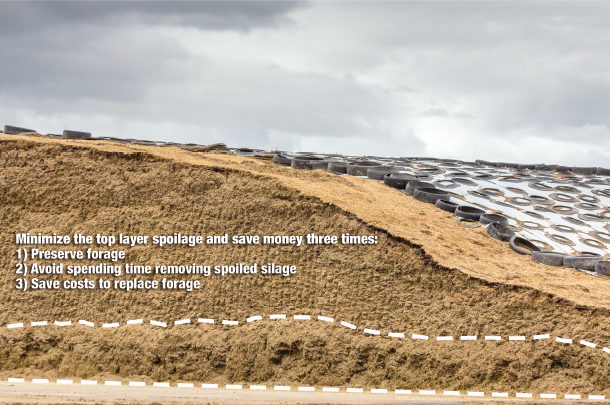If you’ve spent any amount of time studying successful dairies, you quickly realize one of the common denominators is: They are not only great forage producers but also great forage managers.
It’s hard to argue with success, and hopefully your 2020 harvests were successful. Now that your forages are in piles, bunkers or bags, and fermenting as they should, there are several timely considerations for feedout management and review of 2020 harvest. This should lead to initial planning for 2021 that may help to improve your overall forage program. Our proposed post-harvest checklist follows, and we encourage you to develop one specific to the goals of your dairy.
Feedout management considerations
-
Feed inventory – Several reports for 2020 corn silage harvest indicated “bumper” crop yields, whereas a few reported shortages due to drought compared with previous average yields. What were your yields and how do they compare with previous yields for your operation? While we are always tempted to compare our yields with those of our neighbors, it’s more important to know how you are trending year over-year. Knowing what your feed inventory is in November helps you and your nutritionist develop a plan for the upcoming year.
- Feedout critical control points (CCP) – At Chr. Hansen, we focus on about eight CCP, depending on the crop, in order to ensure success during harvest, preservation and storage. Likewise, there are a few CCP for feedout that can improve efficiency and quality of silages:
o Face management – Face management can influence several factors that directly relate back to feed quality and, subsequently, animal productivity. Our data showed that across numerous farms using different inoculants, aerobic stability (lack of heating) of the TMR in the feedbunk was significantly influenced by method of feed removal. Using either a rotary defacer or rake provided longer aerobic stability of the TMR in the feedbunk compared to no defacer or simply using the payloader bucket to deface silage. Furthermore, a rotary defacer was superior to a rake for prolonging aerobic stability of the TMR.
o Feedout rate – What is your current feedout rate for corn silage and haylage? While you know how many pounds each cow is supposed to receive, what does that translate to in inches of daily feedout at the face of the pile? Does this value follow the industry-recommended guidelines of removing no less than 10 to 12 inches of corn silage and 4 to 6 inches of haylage per day? Are your values different during winter feeding and cold weather versus summer feeding and hot weather? If you are not meeting current recommendations, what opportunities are available to help reach the goal? Do you have multiple piles and bunkers from which you’re feeding at the same time? Can you reduce the number of piles and bunkers open at any given time? If you cannot meet these recommendations this year, can you modify your bunk or pile for next year’s harvest to better achieve
these goals?
o Acquired contaminants – Are you doing everything practical to minimize the risk of contaminants being brought into the feed center? Typical sources of contaminants and potentially pathogenic organisms include bird droppings, mud or soil and manure from equipment tires or tracks. What is the overall feed and TMR hygiene of your dairy? Are you feeding “clean feed”?
o Top layer management – Oxygen is the enemy of silage preservation. The primary area where oxygen elimination is most difficult is the top layer of a silage pile or pit. Several management practices will minimize top layer spoilage, such as use of a science-based, research-proven, oxygen-scavenging inoculant; using an effective oxygen-barrier plastic in addition to the traditional plastic; and placing enough weight, via tires, on the plastic to minimize air ingress to the top layer. Top layer management has a triple payback as you preserve the top layer of forage, avoid the cost and safety challenges of removing spoiled silage, and eliminate the need to purchase forage to replace what you had to discard.
o Feedout transition and “the fall slump” – At some time, every dairy will transition from “old” to “new” silage. Often, this transition can be executed seamlessly without incident, but occasionally it doesn’t and the losses and impact can be immediate, harsh and long-lasting. What is your feedout transition plan, and when will it occur?
2020 review and planning for 2021
- Was the entire harvest process done in a safe and efficient manner? – Safety should always be our number one priority. Did you take all reasonably prudent measures to ensure a safe harvest?
- Did you hit your crop-specific numbers? – Most dairies we work with are tuned in to their corn silage maturity, moisture, theoretical length of chop and KPS during harvest, as well as maturity, moisture and RFQ for alfalfa haylage. Did you hit your target values? If not, why were targets missed?
- Planning pays – Although harvest windows are short, planning for successful forage production is a year-long process. Do you have a “point” person who can invest in agronomic research and planning, bunker space management, weather monitoring and communication with harvesting team members? Does everyone understand the “why” of what they are doing and how to do it? Now, during the downtime, is the perfect time for employee training.
- What do you want to change in 2021? – Make your wish list, and list everything that went wrong or that you would like to change. Focus on what is practical, feasible and will return the greatest benefit. Prioritize needed changes and start developing an action plan to make 2021 even more successful. Consider taking photos or do short videos to help illustrate where things can be improved.
- Inoculant applicator maintenance – Check and replace worn or broken parts. Thoroughly clean (soap and water) and sanitize (disinfectant) your inoculant applicator before storing.
- Early booking of silage inoculants – Using inoculants is a “given” for most dairies because they value the quality enhancements that science-based, research-proven inoculants provide for speed of fermentation, nutrient preservation and aerobic stability. As you enter the feedout phase, ask yourself: Are you happy with the results of the inoculants you used in 2020, or do you need to make some changes? How are your cows responding to the forages? Have you early ordered silage inoculants for 2021 to receive the best price?
- Silage storage footprint – Do you anticipate using the same forage storage footprint in 2021, or do you need to consider changing some dimensions? Monitor feedout rate relative to herd goals and inventory needs prior to answering this question.
People are powerful and communication is essential
Over the years, we have asked owners of exceptional dairies across the country to highlight the key factors that make their forage management programs so successful, and without question it boils down to people and communication. We realize there is both a science and art to feeding cows, and the vast majority of owners conveyed that it takes time, feedback and positive reinforcement to create harvest crews and feeding specialists who care and realize just how important their contributions are to the success of the dairy. It’s a collective team effort. ![]()
PHOTO ILLUSTRATION: Photo illustration by Mike Dixon.
Kimberley Morrill and David Ledgerwood are technical service managers with Chr. Hansen Animal Health & Nutrition.

-
Keith A. Bryan
- Technical Services Manager, Ruminant DFM & Silage Inoculants
- Chr. Hansen Animal Health & Nutrition
- Email Keith A. Bryan













